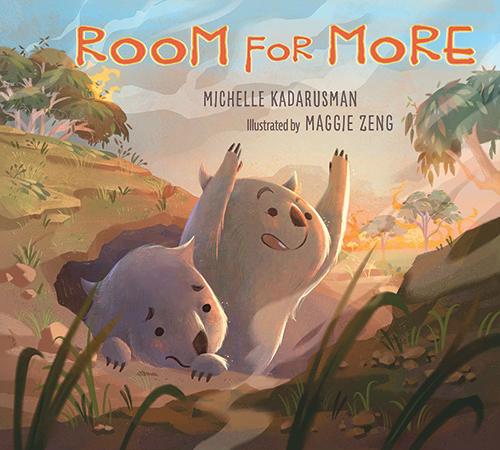
Room for More
Reviewed by Margaret Crompton with assistance from Bethan
May 1, 2023
By Michelle Kadarusman, illustrated by Maggie Zeng. Pajama Press, 2022. 32 pages. $18.95/hardcover. Recommended for ages 5–8.
We’re reviewing this book in an English summer that has suffered drought, wildfires, and floods. But we’re safe. At the same time, many homes here that have “room for more” welcome people seeking refuge from the war in their homeland Ukraine.
Sitting comfortably on my settee, we’re sharing insights we might not have found on our own. Bethan is eight; I’m ten times older (but not ten times wiser). As we summarize our conclusions, Bethan says, “It’s wonderful.” We both pause, then she says exactly what I’m thinking: “Amazing!” We’ve explored the book in terms of story, illustrations, and information. What has earned that rare accolade?
Set in Australia, two wombats find room in their burrow to shelter a wallaby and her joey (baby), a koala, and a tiger snake, whose homes are threatened by bushfires. Scratch is dismayed by Dig’s spontaneous offers of hospitality, and announces, “There is no room.” Since the guests save the burrow from flooding, however, Scratch later declares: “Aren’t we clever to have invited the neighbors into our home.” Notes give information about the Australian author, animals, and issues connected with climate change.
The book is a galley of full-page, double-spread pictures. Although I wonder if Bethan might find the colors unappealing, she immediately recognizes that every page represents a different aspect of the story. At the beginning, the countryside is green and the sky blue. Then bushfires create a smoky haze, and the predominant color becomes fiery red. While I point out flowers already blooming after the fires, Bethan teaches me to notice details: raindrops on the wallaby’s ears, sun reflected in flood water. She describes clouds as “nice and dabby.” Pedantically, I ask her to explain “dabby.” With her guidance, I notice a pinkish cloud emerging from the post-fire blue to become lighter as it reflects sunlight and fades back into the blue: “dabby.” A picture of a tree leads Bethan to imagine feeling its texture without actually feeling it.
One picture leads to puzzled discussion about the construction of the wombat burrow. But all other pictures satisfy Bethan’s requirement to “show—no need to tell”; enabling readers to “see what’s going on.” For younger children, the animal shapes are clear and simple—free from irrelevant detail. They have soft faces, like soft toys, and are (to our relief) unclothed.
Although the central figures, wombats Dig and Scratch, have distinct attitudes and personalities, they work together to save the other animals. Later these animals cooperate to save the wombats. This theme reflects the last book Bethan and I reviewed, Desmond Gets Free, in which numerous mice combine to dislodge an elephant from their friend’s tail.
We are both comfortable with the didactic content. Bethan is also impressed by an example of recognizable behavior when Scratch objects to Dig’s generous hospitality (in Scratch’s opinion, overly generous). She understands that the simple dialogue illustrates everyday experience: “when you’re having an argument but you don’t want to lose your friend, you don’t want to hurt their feelings because you’d feel bad for them because of something you’ve said, so you’re like Scratch.”
From our different ages and perspectives, we agree that this is a good book to share: to learn “in a fun way,” to enjoy, and to be together. As I finish writing this in fall 2022, many Russians are leaving their homeland to avoid mobilization against Ukraine. They seek refuge in homes with “room for more.”
Margaret Crompton (Britain Yearly Meeting) wrote the Pendle Hill pamphlet Nurturing Children’s Spiritual Well-Being (2012). Recent publications include poems, short stories, and plays. Bethan writes poems; her first publication was the review of Desmond Gets Free in the May 2022 Friends Journal.



Comments on Friendsjournal.org may be used in the Forum of the print magazine and may be edited for length and clarity.